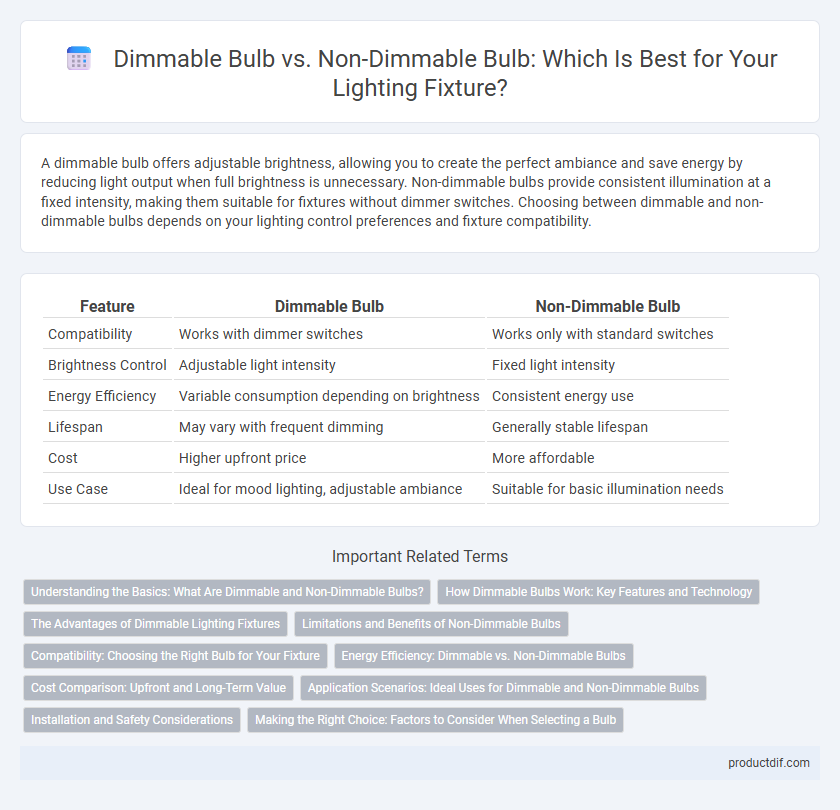A dimmable bulb offers adjustable brightness, allowing you to create the perfect ambiance and save energy by reducing light output when full brightness is unnecessary. Non-dimmable bulbs provide consistent illumination at a fixed intensity, making them suitable for fixtures without dimmer switches. Choosing between dimmable and non-dimmable bulbs depends on your lighting control preferences and fixture compatibility.
Table of Comparison
| Feature | Dimmable Bulb | Non-Dimmable Bulb |
|---|---|---|
| Compatibility | Works with dimmer switches | Works only with standard switches |
| Brightness Control | Adjustable light intensity | Fixed light intensity |
| Energy Efficiency | Variable consumption depending on brightness | Consistent energy use |
| Lifespan | May vary with frequent dimming | Generally stable lifespan |
| Cost | Higher upfront price | More affordable |
| Use Case | Ideal for mood lighting, adjustable ambiance | Suitable for basic illumination needs |
Understanding the Basics: What Are Dimmable and Non-Dimmable Bulbs?
Dimmable bulbs are designed with special electronics that allow them to adjust brightness based on the compatible dimmer switch's settings, providing customizable lighting levels and energy savings. Non-dimmable bulbs operate at a fixed brightness and do not support variation, often leading to flickering or damage if used with dimmer switches. Choosing the right bulb type ensures optimal performance and longevity in lighting fixtures, matching the intended use and control systems.
How Dimmable Bulbs Work: Key Features and Technology
Dimmable bulbs use advanced electronic components such as TRIAC or MOSFET dimmers to regulate electrical current, enabling adjustable brightness levels. These bulbs contain specially designed filaments or LED drivers that respond seamlessly to voltage changes without flickering or damage. Their compatibility with various dimming systems allows precise light control for energy saving and ambiance customization.
The Advantages of Dimmable Lighting Fixtures
Dimmable bulbs offer precise control over light intensity, allowing users to create customized ambiance and reduce energy consumption by adjusting brightness levels to suit different activities. These fixtures extend bulb lifespan by operating at lower power settings, reducing heat output and wear on components. Enhanced flexibility in lighting design and improved mood regulation make dimmable lighting fixtures a valuable choice for residential and commercial environments.
Limitations and Benefits of Non-Dimmable Bulbs
Non-dimmable bulbs offer a straightforward, cost-effective lighting solution with consistent brightness, making them ideal for standard fixtures without dimmer switches. Their limitation lies in incompatibility with dimmer controls, which can cause flickering, reduced bulb lifespan, or damage. Despite this, non-dimmable bulbs provide reliable, stable illumination for everyday use where adjustable light levels are unnecessary.
Compatibility: Choosing the Right Bulb for Your Fixture
Dimmable bulbs are specifically designed to work with compatible dimmer switches, allowing users to adjust brightness levels without flickering or damage. Non-dimmable bulbs, when used with dimmer switches, often result in flickering, reduced lifespan, or malfunction, making compatibility crucial for optimal performance. Selecting the correct bulb based on your fixture's dimming capability ensures energy efficiency, lighting control, and longevity of the fixture.
Energy Efficiency: Dimmable vs. Non-Dimmable Bulbs
Dimmable bulbs optimize energy efficiency by allowing users to adjust brightness levels, reducing electricity consumption compared to non-dimmable bulbs that operate at a fixed output. LED dimmable bulbs, in particular, can lower energy usage by up to 30-50% when dimmed. Non-dimmable bulbs lack this flexibility, leading to consistent and potentially higher energy consumption during operation.
Cost Comparison: Upfront and Long-Term Value
Dimmable bulbs typically have a higher upfront cost compared to non-dimmable bulbs due to advanced technology and compatibility features. Over time, dimmable bulbs offer energy savings by allowing adjustable brightness, which can reduce electricity bills and extend bulb lifespan. Non-dimmable bulbs have lower initial costs but lack long-term financial benefits associated with customizable lighting control.
Application Scenarios: Ideal Uses for Dimmable and Non-Dimmable Bulbs
Dimmable bulbs are ideal for living rooms, dining areas, and bedrooms where adjustable lighting enhances ambiance and supports activities like reading or relaxing. Non-dimmable bulbs suit spaces requiring consistent brightness, such as kitchens, bathrooms, and workspaces, ensuring optimal visibility and safety. Selecting the appropriate bulb type based on application scenarios maximizes energy efficiency and lighting comfort.
Installation and Safety Considerations
When installing dimmable bulbs, ensure compatibility with dimmer switches to prevent flickering or damage, as non-dimmable bulbs used on dimmers can overheat and pose fire risks. Proper wiring and adherence to manufacturer guidelines enhance safety and performance, while non-dimmable bulbs offer straightforward installation without the need for specialized controls. Always verify electrical ratings and local codes to maintain safe operation and avoid voiding warranties.
Making the Right Choice: Factors to Consider When Selecting a Bulb
Selecting between a dimmable bulb and a non-dimmable bulb depends on the lighting control needs and the fixture compatibility. Dimmable bulbs offer adjustable brightness for ambiance and energy savings but require compatible dimmer switches to function correctly. Non-dimmable bulbs provide consistent brightness and are generally more cost-effective but lack flexibility in light intensity adjustment.
Dimmable Bulb vs Non-Dimmable Bulb Infographic

 productdif.com
productdif.com